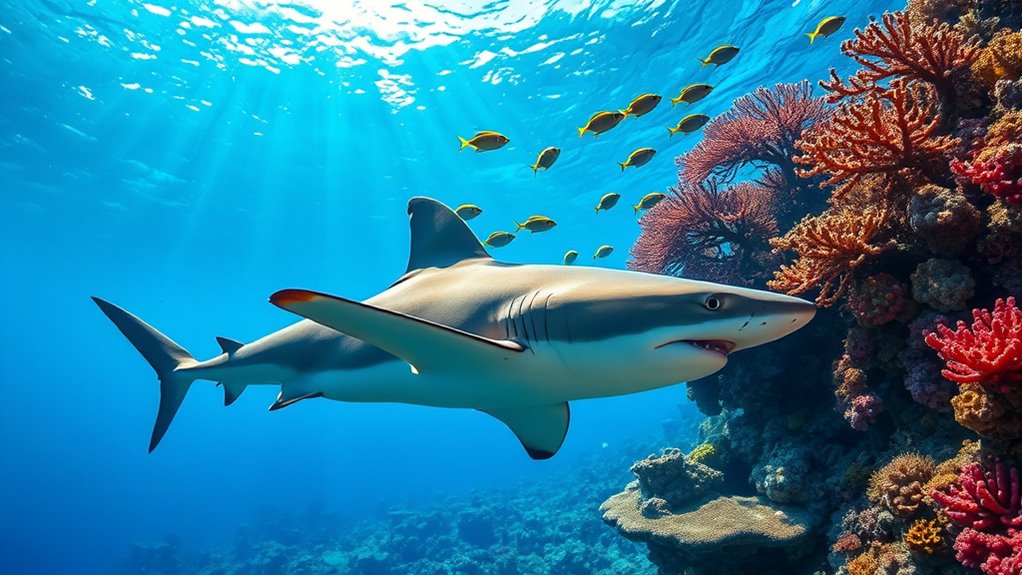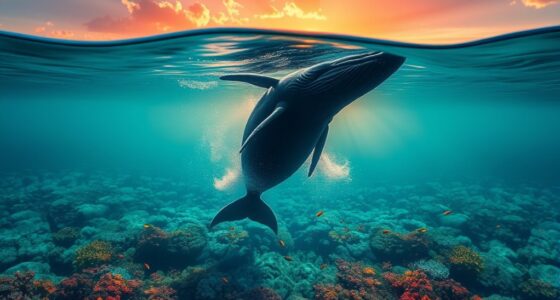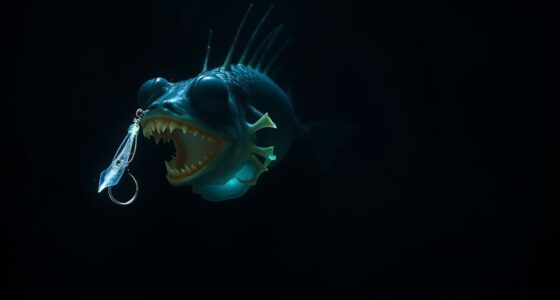Recent conservation efforts are showing promising results, giving hope for sharks and our oceans. Marine protected areas provide safe spaces where sharks can breed and thrive, helping populations rebound. Sustainable fishing practices reduce overharvesting and bycatch, further aiding recovery. Evidence from these initiatives proves that positive change is possible and inspiring further action. If you’d like to see how these successes are shaping the future of our marine ecosystems, there’s more to discover ahead.
Key Takeaways
- Marine protected areas are providing safe habitats, enabling shark populations to recover and thrive.
- Evidence shows increasing shark numbers within MPAs demonstrate successful conservation efforts.
- Sustainable fishing practices reduce bycatch, helping stabilize and rebuild shark populations globally.
- Public awareness campaigns promote responsible behaviors, supporting long-term shark conservation initiatives.
- Overall, conservation measures are yielding tangible signs of shark population recovery and ecosystem health.

Have you noticed how efforts to protect sharks are making a real difference? Across the globe, conservationists and governments are stepping up to safeguard these essential predators, and their work is starting to show positive results. One of the key strategies has been the creation of marine protected areas (MPAs), which serve as safe havens where sharks can thrive without the constant threat of overfishing. These protected zones help replenish shark populations by offering undisturbed habitats, allowing them to breed, hunt, and grow in healthier environments. When sharks are given space to recover, the entire marine ecosystem benefits, since they play a critical role in maintaining the balance of ocean life.
Alongside establishing MPAs, promoting sustainable fishing practices has become a fundamental part of shark conservation. Overfishing remains a major threat to many shark species, especially when illegal or irresponsible fishing methods target them directly or inadvertently catch them as bycatch. By adopting sustainable fishing practices, fisheries can reduce bycatch, avoid overharvesting, and ensure that shark populations are not pushed to the brink. These practices include using selective gear, setting catch limits based on scientific data, and enforcing stricter regulations on fishing quotas. As more fisheries embrace these methods, the pressure on shark populations eases, allowing numbers to stabilize and even increase in some regions. Implementing sustainable fishing practices also requires ongoing monitoring and enforcement to maintain effectiveness over time. Moreover, public awareness campaigns are helping to encourage responsible consumer choices that support conservation efforts.
You might be surprised to learn that these combined efforts are already yielding tangible results. In areas where MPAs have been established and sustainable fishing practices are enforced, shark populations are showing signs of recovery. For example, studies have documented increases in certain species within protected zones, indicating that these measures are effective. These rebounds are encouraging signs that, with continued commitment, we can reverse some of the damage inflicted on shark populations. Furthermore, these successes inspire further action, encouraging more regions to adopt similar protections and sustainable practices. Additionally, the role of marine protected areas in providing safe habitats is crucial for long-term recovery efforts, especially as they help preserve biodiversity and restore ecological balance. Implementing public awareness campaigns can also significantly influence the success of conservation initiatives by fostering a conservation-minded public.
Frequently Asked Questions
Which Shark Species Have Shown the Most Significant Recovery?
You should know that several shark species have made notable recoveries. The grey reef shark, for instance, has seen its population increase in protected areas, hitting key recovery milestones. Similarly, the whale shark’s numbers are steadily rising in some regions thanks to conservation efforts. These successes give hope that targeted actions can boost shark populations, helping restore balance in our oceans and emphasizing the importance of continued protection measures.
How Do Local Communities Benefit From Shark Conservation?
You benefit from shark conservation through community involvement that fosters a sense of ownership and responsibility. When local communities participate in protecting sharks, they often gain economic incentives like eco-tourism and sustainable fishing practices. These activities create jobs and boost local economies, providing long-term stability. By supporting conservation efforts, you help preserve marine ecosystems, ensuring healthy oceans and livelihoods for future generations.
What Are the Biggest Challenges Still Facing Shark Conservation Efforts?
Did you know over 100 million sharks are killed annually? You face challenges like weak marine policies that fail to protect these predators and threats to the ecological balance they maintain. You need stronger enforcement and global cooperation to combat illegal fishing and habitat destruction. Without addressing these issues, shark populations will continue to decline, risking larger ecosystem collapse. Your efforts can help push for better policies and sustainable practices.
How Can Individuals Contribute to Shark Protection?
You can contribute to shark protection by raising public awareness about their importance and the threats they face. Support sustainable fishing practices by choosing responsibly sourced seafood and advocating for policies that protect sharks. Educate others about shark conservation, share information on social media, and participate in local events. Your actions help foster a broader understanding and drive positive change, making a real difference in safeguarding sharks for future generations.
Are There Any Innovative Technologies Aiding Shark Conservation?
Like explorers charting new waters, you’ll find innovative technologies aiding shark conservation. Shark tracking uses satellite tags to monitor their movements, helping protect critical habitats. Habitat sensors provide real-time data on water quality and temperature, alerting us to changes that threaten sharks. By supporting these advancements, you contribute to smarter conservation efforts, ensuring these magnificent creatures thrive in our oceans for generations to come.
Conclusion
As you witness these shark conservation successes, remember that hope is a guiding light amid ocean’s darkness. Like a lighthouse standing tall against stormy seas, our efforts have shown that change is possible. Every small victory ripples outward, proving that with dedication, we can turn the tide for these essential predators. So, keep believing in the power of collective action—because together, we’re steering our oceans toward a brighter, more balanced future.







